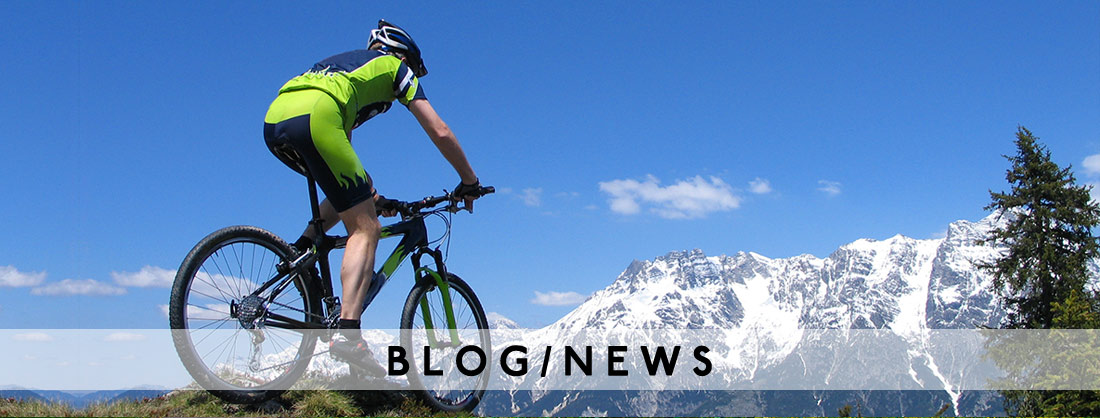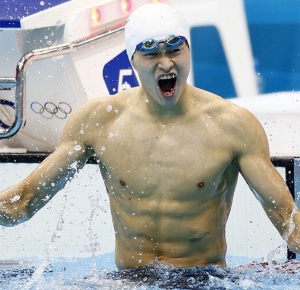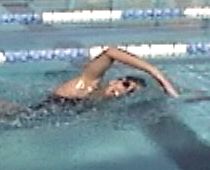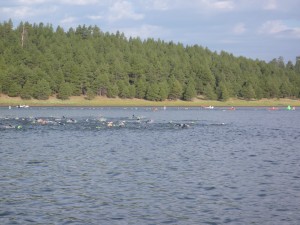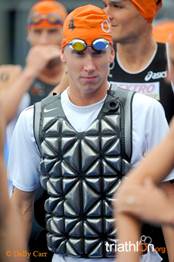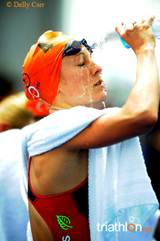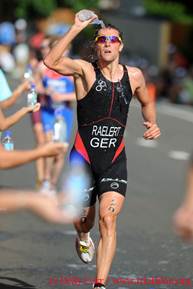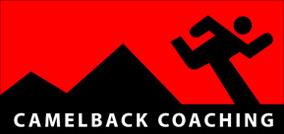Swimmers are a hard lot. We enter the pool at 5:30 in the morning, swim massive yards—swim them hard—and then do it again in the afternoon. We do it day after day. No easy sets. No extra rest. All pain. All guts. No glory. The only easy day was yesterday and all that. Right? Because to swim fast, we must do the following: Kick hard. Pull hard. Train hard. Swim hard. Race hard.
Hard, hard, hard.
I know because I’ve been there. I swam for thirteen years with Bob Gillett, who famously coached Misty Hyman to a gold medal in the 200-meter butterfly at the 2000 Sydney Olympics. In the early seventies and eighties, big yardage was the name of the game. As a seventh grader, I walked to school each morning after an 8,000-yard swim practice with wet hair and a tired smile, having derived a strange, masochistic pride from this, from working hard. If you are, or were, a competitive swimmer, you know exactly what I’m talking about. Then, after school, I got back in the pool and did it again. Day after day. Same thing. And this continued into my years as a collegiate swimmer at the U.S. Naval Academy. So I get it. Working hard. I really get it.
I think we all carry an innate sense of what working hard looks like. In swimming, the rooster-tailed, ferocious kick is a telltale sign that a swimmer is indeed working hard.
Those of you who have been coached by me, know I’m enamored with Sun Yang, the current world record holder in the 1500-meter freestyle. Why? Because he’s turning traditional thinking for how to go fast on its head. He’s doing what 99 percent of swim coaches in the world say you shouldn’t do, even for a distance specialist: He doesn’t kick enough. When he swims the 1500, he uses four kicks per stroke cycle. Only four. And at the London Olympics in 2012, where he breaks his own world record, there were plenty of times during his swim when he used only two kicks per stroke cycle! Check out the video. Watch it for yourself.
This mindset of swim hard, kick hard, etcetera, is well ingrained in swimmers from the time we are small. But rather than try to describe this, I thought I’d let race commentary speak for itself.
I’ve excerpted much of what was said by two Australian commentators during Sun Yang’s historic swim at the Shanghai Aquatics Center in the summer of 2011 when he broke Grant Hackett’s 10-year-old record in the 1500-meter freestyle.
The announcers, Nicole Livingstone, an accomplished Australian Olympic swimmer, and Anthony Hudson, an Australian sportscaster, are incredulous—incredulous—when calling Sun Yang’s performance.
Particularly in Nicole’s case, it goes against everything she’s been taught, everything she knows. And the thing is, I get her. I understand the deeply-rooted psyche of a competitive swimmer, who grew up swimming when I did, who was successful because of the hard work and countless yards she put it in.
During the commentary, you hear it in her voice. In the inflection, tone, and cadence. I’ve tried to highlight those moments in the text below by italicizing when she emphasizes certain words.
Simply put, her reaction is a telling statement on the swimming community’s collective mindset of what it looks like to go fast—it should look hard, as evidenced by a strong kick, of course.
This particular video clip begins 4:27 into Sun Yang’s swim.
https://www.youtube.com/watch?v=u6uqZd8Tn3Y
For reference, the announcers’ words are written in blue. My comments are in black. The first time listed is the elapsed time in the video clip itself. The second time is Sun Yang’s running swim time. And finally, I’ve indicated who is speaking. I’ve not bothered with proper punctuation, truncating where necessary for brevity. Notes in brackets within the text of the commentary are my own additions.
:04/4:31/Nicole: buries his head quite a bit on his recoveries
A high heads-up swim position used to be the norm, so it’s not surprising that Nicole would use the term “buried” to describe a head position where the head is straight and aligned with the spine.
:10/4:35/Nicole: here’s the underwater, so nice elbow. Look at the pitch on the elbow!
Much of the post-race analyses I’ve read regarding Sun Yang’s races focus on his high elbow catch underwater. Indeed, this is brilliant. He is strong and fit and has trained countless yards to be able to hold this high elbow positioning during the catch for 1500 meters.
:15/4:40/Nicole: but he does bury the head when he’s on his recovery strokes
At 500 m, 4:51:43, +2.61 WR [I’ve added splits and time above WR pace throughout in bold]
:32/4:57/Nicole: I don’t know whether or not that means there’s a slight amount of fatigue there . . . not looking at by how efficient he is and how easy he seems to be doing it
:42/5:07/Anthony: well, it just seems like Cochrane [Ryan Cochrane from Canada, in second place] has to work so hard going back up the pool to try and stay on pace
True, it does look like there’s a lot more going on in the pool a few lanes over. If Ryan was leading at this point, it would be “well deserved” because it looks like he’s working hard.
1:08/5:33/Nicole: really relaxed kick, as well
1:13/5:38/Nicole: but otherwise, the feet are just dragging along behind him with a really nice balance to help out the arms
1:21/5:46/Nicole: when he wants to sprint, those feet will come up, and get a lot quicker and really start going to a 6-beat kick, but just [exasperated sigh]. . . dragging at the moment
Nicole describes Sun Yang’s crisp, integrated kick as legs dragging or floating five different times in the commentary.
1:33/5:58/Nicole: nice high elbow. The pitch on the elbow is just so dramatic.
1:37/6:04/Nicole: so the arm is extended and it’s from the elbow to the hand that bends all the way down underneath him and then the rest of the arm follows to finish the stroke. It’s just phenomenal.
Nicole loves a good catch. Now that is hard swimming.
1:58/6:15/Nicole: and the amount of work that he would do in the training pool with Denis Cotterell [Sun Yang’s coach and also Grant Hackett’s coach] to be able to race a fast 1500, is somewhere around 30 hours a week in the water . There’s a lot of cross-training that goes on, as well, these days. So he would be a very fit boy . . . very swimming fit and water fit, doing anywhere up to 100 kilometers a week in the water . . . for just 1500 meters.
Nicole speaks clearly and confidently about the merits of Sun Yang’s catch and also about his training and high volume. True, good technique needs many yards behind it to do what Sun Yang is doing.
At 700m, 6:48:81, +2.85 WR
3:13/7:40/Nicole: there is no bubbles or whitewash under him at all
At 800m, 7:47:45, +2.98 WR
3:26/7:53/Nicole: look at that, there’s just hardly any wash underneath
3:29/7:56/Nicole: well, you see Ryan Cochrane on the other side as he enters his hand is a whole heap of bubbles that follows him down
3:35/8:02/Nicole: Cochrane looks like he’s sprinting to keep some kind of contact with Yang
4:09/8:36/Nicole: look at the legs, they’re just dragging. It’s almost like he’s doing a recovery freestyle
At 900m, 8:46:11, +3:06 WR
5:02/9:29/Nicole: well, he’s obviously swimming fast because the other competitors can’t keep up with him. I think it’s a little bit misleading looking at how efficient his technique is. It makes you think like he’s not swimming hard. I’m sure he is going hard given that he’s going 29. 4, 29.3, 29.2
Nicole is having a difficult time reconciling what she’s seeing. Yes, Sun Yang is swimming fast. And the statement, “It makes you think like he’s not swimming hard,” says a lot. Darn it, Sun Yang. You’re supposed to look like you’re swimming hard! Don’t you understand? How can I call this race if it doesn’t look like you’re trying hard?
At 1000m, 9:44:98, +3.20 WR
5:19/9:44/Nicole: now . . . I think Denis Cotterell would have said to him, ‘the last 500 meters, really start to work this, start to pick it up, start to give it something
As if he’s not working hard already. . . Of course, because of how “easy” he makes it look, she would assume his coach would say something like this. Warm-up’s over. Time to work. Hard.
6:04/10:29/Nicole: so still, no sense of urgency for him
6:10/10:35/Nicole: you can see the extension as he enters the water with his hand, how far that hand goes forward, lunges forward, under the water
At 1100m, 10:43:67, +3.11 WR
6:29/10:54/Nicole: still straight down the center of the lane, he has not deviated from the center of the lane
6:38/11:03/Nicole: head buried quite prominently when he breathes and he puts the head back down and really gets down low
Neutral head position. That’s a real humdinger.
6:59/11:24/Anthony: Hackett’s last hundred was just on 57 seconds, so waiting to see what sort of time Sun Yang, if he’s still within striking range, could achieve
At 1200m, 11:42:21, +2.70 WR
7:36/12:01/Nicole: there’s the underwater again. The lower half of the arm bends first after the entry, then the whole arm moves past down to the leg
7:52/12:17/Nicole: and moving toward the lane rope a little bit, so maybe he’s starting to close his eyes a little bit more and trying to exert himself just a touch more
Nicole at this point is desperate for some exertion. Some evidence that Sun Yang is trying. That he’s working hard.
At 1300m, 12:41:16, +2.65 WR
8:17/12:42/Anthony: 2.65, he is gaining ground
8:48/13:13/Nicole: if he’s going to do any sort of world record, he needs to move soon. I mean, he’s running out of race distance. That’s the pure fact of it.
She almost gets a little smug here. See, I told you. If you don’t work hard . . . well, that’s just the pure fact of it.
9:04/13:29/Nicole: so maybe Grant Hackett’s world record will live to fight another Olympic Games. It’s been there since 2001.
She is hopeful indeed. This person, executing a ridiculously efficient swim stroke with the “dragging” legs just cannot move past a phenom like Grant Hackett, who utilized one of the strongest, sustainable kicks in swimming history.
9:12/13:38/Nicole: there’s the bell lap
At 1400m, 13:39:92, +2.03 WR
9:13/13:39/Nicole: What’s he got? What’s he got left? Is he tired?
9:20/13:46/Nicole: Oh! There’s the kick!
Finally! This is it! This is how you go fast! She is the most excited she has been the entire race. Listen to her voice.
9:22/13:48/Anthony: He’s really starting to rev it up now!
Yes! He’s working hard now! This is how you swim!
9:29/13:55/Anthony: Sun Yang of China is working hard here!
Anthony says this proudly. Again. Finally. Something that makes sense. Hard work. He’s kicking hard. He’s in the last 75 meters of the race, but never mind that.
9:38/14:04/Nicole: But look at the kick! I mean, he has had his legs floating for the first 1400 meters and it’s just been the most easy of strokes and now, look at the kick on him. The feet are right out of the water!
Halleluiah! The kick. He has a kick! He’s less than 25 meters from the finish, and finally, he’s decided to do it right!
9:50/14:16/Anthony: Well, he’s going for it! He’s really gonna challenge here! This world record line, hopefully we’ll see it very shortly. Sun Yang of China, 14:23. We’re talking about a mark of 14:34:06. He’s gaining on it all the time! Grant Hackett will be very nervous right now!
10:07/14:33/Anthony: Oh, what a performance! He’s gonna do it!
At 1500m, 14:34:14, -0.42 WR
10:12/Anthony: Both records are gone! [World Record and Chinese Record]
10:19/Nicole: What a time!
10:21/Anthony: What an amazing way to do it, too, Nicole!
10:23/Nicole: That is just incredible. He was nowhere near it with 100 to go. I think it was 2.6 he was away from it. And the last 100 meters, he’s gone 54 flat. 54 seconds in the last 100 meters. That was incredible. Imagine how fast he could go if he tried the whole way!
This is bar none the greatest line in the entire commentary. It all boils down to this in the swimming psyche.
10:49/Anthony: And what an amazing mark, 14:34:14. So Grant Hackett’s record has been beaten. It was the one that survived . . . and we were hanging on to that one.
11:07/Nicole: But we should say it stays at the Miami Swimming Club with Denis Cotterell, Sun Yang’s coach. Well done to Denis. A lot of hard yards, standing in the outdoor pool have been done between Sun Yang and Denis Cotterell
Yes, of course. It was the hard yards.
11:23/Nicole: Wow. That was phenomenal. His stroke is just so efficient. So efficient. And then when he wants to put on a turn of speed, he just brings those legs in. Look at them. They’re just floating there. And in the last 100 meters, it was 54 flat. And he’s just brought in this massive 6-beat kick. And it wasn’t even the last 100. It was the last 50. His last 50 meters was 25.9.
11:51/Anthony: It’s astonishing. As you said, he had plenty in reserve, didn’t he?
If you’ve made it this far in the article, congratulations. My hope is that this will make you think about what “hard” means. Swimming like Sun Yang—executing a clean, tight stroke with no bubbles or whitewash, while maintaining a high-elbow catch—is indeed hard. It is exacting. It takes hundreds of thousands of yards of dedicated, disciplined practice.
But the main point here is that a swim stroke shouldn’t look hard. If it looks hard, there’s probably a lot of extra stuff going on that’s creating unnecessary drag.
Would you ever want to watch a ballet dancer that looked like they were working hard? These are some of the strongest athletes in the world, but you would never know it. Which is as it should be.
Take that same example and move it underwater to your favorite aquatic animal–a fish, a dolphin, a shark. If they’re spastically shaking their tails, something is very wrong. These animals disturb the water hardly at all as they move through it, having evolved over millions of years to cut the cleanest possible line through the aquatic medium. You might see a momentary series of fast twitches of the tail if a fish needs a quick burst of speed, just like a human sprinter uses a strong kick for short periods or Sun Yang uses one to sprint home in the last 50 meters.
After any quick turns of speed, however, the fish returns to a quiet, rhythmic movement, no bubbles, no splash—but they are still moving fast. What does this mean for humans? For long-distance swimmers, in particular? A savage kick on the back end might not be necessary. Denis Cotterell certainly recognized this. He didn’t force Sun Yang into a box—into doing excess kicking he clearly doesn’t need. Bottom line, swimming in a quiet, graceful way in order to go fast should be ok. The experts—that is, any fish (and one human world record holder)—will attest to this.

